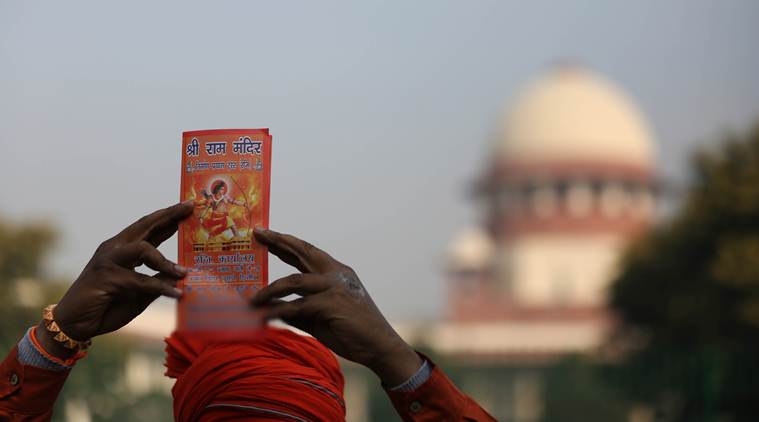The Sunni Central Wakf Board on Tuesday accepted that Ram was born at the spot known as Ram Chabutra which is in the outer courtyard of the disputed site in Ayodhya, even as the Supreme Court questioned why the 16th-century Ain-i-Akbari was silent on an “important” mosque like the Babri Masjid.
Senior advocate Zafaryab Jilani, representing the Board, told a five-judge Constitution bench hearing the Ramjanmabhoomi-Babri Masjid dispute case that it had accepted the Chabutra as the birthplace of Ram as the Faizabad district judge had held that the spot — 60-65 feet from the Babri Masjid, which was demolished in 1992 — was worshipped by Hindus as Ram’s birthplace.

Jilani was responding to Justice S A Bobde who asked, “You don’t dispute Chabutra as the place of birth?”
The counsel replied, “Earlier we had. But the district judge said it was worshipped believing it to be the birthplace.” His reference was to the 1885 decision rendered by the Faizabad judge dismissing a suit filed by Mahant Raghubar Das seeking permission to construct a temple over the Ram Chabutra.
The bench headed by Chief Justice Ranjan Gogoi and comprising Justices S A Bobde, D Y Chandrachud, Ashok Bhushan and S Abdul Nazeer is hearing appeals against the September 30, 2010 verdict of the Allahabad High Court ordering a three-way division of the disputed 2.77 acres.
The bench also sought to know why Ain-i-Akbari — written in the 16th century, the period when the Babri Masjid was allegedly constructed — did not mention the mosque.
Jilani had sought to rely on the book to establish the claim that no temple was demolished in Ayodhya to construct the Babri Masjid. He said the late historian Jadunath Sarkar had said that Ain-i-Akbari, written by Akbar’s court historian Abu’l-Fazl ibn Mubarak, had the minutest details. “If there was any demolition of a temple in 1528 in Ayodhya, it would not have missed the book,” Jilani said.
Story continues below this ad
Justice Bhushan told him that the Hindu side’s contention was that it did not have all the details. Jilani replied that it only had the important details.
“Are you saying the mosque is not important?” asked Justice Bhushan. Jilani said, “It became important only now. Then (in 1528) it was just another mosque.”
Intervening, Justice Bobde asked, “…If a mosque was built by an emperor, how can you say it is of no importance?” Jilani replied that it was not built by Babur in person but by his commandant Mir Baqi.
Justice Bobde said that if it was on the instructions of Babur, then it was important. Jilani contended that it was the case of the Hindu parties that it was built by Babur, to which Justice Bobde said “it could be wrong”. Jilani said in that case their suit must be dismissed, but Justice Bobde replied that a suit cannot be dismissed just because some part of it is wrong.
The Wakf Board counsel said that “since the entire case is based on faith, we have to ascertain whether it is borne out by the facts”. Pointing to the Ramcharitmanas composed in 1574 and Valmiki Ramayana, he said these texts mention Ayodhya as the birthplace but do not specify any particular spot as the Janmasthan.
Story continues below this ad
Justice Chandrachud said this argument would amount to assuming that all the information about the Hindu faith was contained in these two texts.
Jilani said “there was a temple which was called the Janmasthan temple to the north of the disputed structure” which the Hindus believed to be the birthplace.
Justice Chandrachud drew attention to witness testimonies that Skanda Puran had put the spot of Ram’s birth at about 200 paces west of ‘Sita koop’, a well. Jilani said the same Hindus had believed that the Janmasthan temple was the place of birth.
To this, Justice Bhushan said the Allahabad High Court had held that the Janmasthan temple he was referring to was a recent one. But Jilani said the HC was wrong as there was mention of it in a book published about 150 years ago.
Justice Bobde also referred to a witness testimony about the place of birth being in Dashrath Palace and asked if such a palace exists. Justice Chandrachud pointed out that various spots identified as the birthplace were in “close proximity” to the disputed site. Jilani, however, contended that there was “no witness from whom anything can be inferred about the exact place of birth”.

 The bench headed by Chief Justice Ranjan Gogoi and comprising Justices S A Bobde, D Y Chandrachud, Ashok Bhushan and S Abdul Nazeer is hearing appeals against the September 30, 2010 verdict of the Allahabad High Court
The bench headed by Chief Justice Ranjan Gogoi and comprising Justices S A Bobde, D Y Chandrachud, Ashok Bhushan and S Abdul Nazeer is hearing appeals against the September 30, 2010 verdict of the Allahabad High Court






